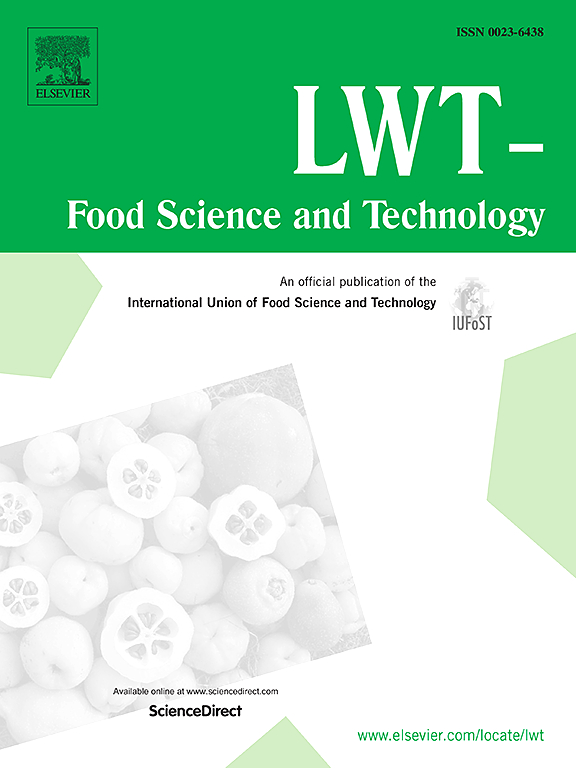鸭汤在烹饪过程中的稳定性变化和风味特征探索
IF 6
1区 农林科学
Q1 FOOD SCIENCE & TECHNOLOGY
引用次数: 0
摘要
鸭汤是一道重要的菜肴,具有独特的风味和丰富的营养,是家庭和餐馆常用的烹饪方法。然而,其制作主要依靠厨师的经验理解而非科学指导,导致口味不稳定、质量参差不齐。因此,本研究探讨了鸭汤在烹饪过程中乳化稳定性、口感和风味的变化。结果显示,烹煮 2.5 小时的鸭汤稳定性指数最高。可溶性蛋白质和 zeta 电位的增加以及颗粒尺寸的减小都有助于提高稳定性指数。光学显微镜观察显示,2.5 小时后,汤中的微纳米颗粒分布均匀。仿生系统分析显示,汤样品在鲜味、咸味和浓味方面差异显著。味觉氨基酸明显增加,单磷酸 5ʹ-腺苷(5ʹ-AMP)+单磷酸 5ʹ-肌苷(5ʹ-IMP)在 2.5 h 达到最高水平,表明此时鸭汤的鲜味更明显。通过多元统计分析,(E)-2-壬烯醛、3-辛烯-2-酮、1-辛烯-3-醇和 2-戊基呋喃被筛选为烹制 2.5 h 鸭汤样品的明显差异标记。这项研究为高品质鸭汤的工业加工提供了指导。本文章由计算机程序翻译,如有差异,请以英文原文为准。
Exploration on the stability changes and flavor profiles of duck soup during cooking
Duck soup is an important dish with unique flavor and rich nutrition, commonly prepared by households and restaurants. However, its preparation mainly relies on empirical understandings of cooks rather than scientific guidance, leading to unstable taste and variable quality. Therefore, in this work, changes in emulsion stability, taste and flavor profiles of duck soup were explored during cooking. Results revealed duck soup cooked for 2.5 h exhibited highest stability index. The rise of soluble protein and zeta-potential, as well as reduction in particle size, all contributed to the improvement of stability index. Optical microscope observation showed micro-nanoparticles in soup were uniformly distributed at 2.5th h. Bionic system analysis revealed soup samples differed significantly in umami, saltiness and richness. Taste amino acids exhibited notable increase and 5ʹ-adenosine monophosphate (5ʹ-AMP) + 5ʹ-inosine monophosphate (5ʹ-IMP) reached the highest level at 2.5 h, indicating more pronounced umami taste in duck soup at this time. Using multivariate statistical analysis, (E)-2-nonenal, 3-octen-2-one, 1-octen-3-ol, and 2-pentylfuran were screened as pronounced difference markers in the sample cooked for 2.5 h. An appropriate equilibrium between stability, taste and flavor profiles of duck soup achieved after 2.5 h of cooking. The research provides guidance for industrial processing of high-quality duck soup.
求助全文
通过发布文献求助,成功后即可免费获取论文全文。
去求助
来源期刊

LWT - Food Science and Technology
工程技术-食品科技
CiteScore
11.80
自引率
6.70%
发文量
1724
审稿时长
65 days
期刊介绍:
LWT - Food Science and Technology is an international journal that publishes innovative papers in the fields of food chemistry, biochemistry, microbiology, technology and nutrition. The work described should be innovative either in the approach or in the methods used. The significance of the results either for the science community or for the food industry must also be specified. Contributions written in English are welcomed in the form of review articles, short reviews, research papers, and research notes. Papers featuring animal trials and cell cultures are outside the scope of the journal and will not be considered for publication.
 求助内容:
求助内容: 应助结果提醒方式:
应助结果提醒方式:


